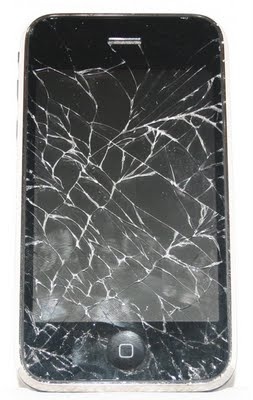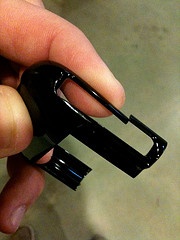Case Buying 101
What should you watch out for when buying a new iPhone case.

Choosing a case is one of those important first steps that you take after buying an iPhone. It's a decision that shouldn't be taken too lightly or made too hastily. I've seen far too many anxious people run over to the case wall at the Apple Store, get drawn in by the bright colors and cool textures, find the perfect match, and returning it weeks later because they didn't pay attention to the little things. What are those little things? Well, much like buying a vehicle to drive around small children, safety should be your first priority.
 Hard vs. Soft Cases
Every great case debate begins with the topic of Hard vs. Soft and which one provides better protection? While there's no simple answer and it really needs to be taken on a case by case (no pun intended) basis, some conclusions have been reached by the iPhone community. The whole argument behind using a rubber or silicon case for protection comes from the idea of lengthening the time of impact, similar to crumple zones on cars. This was once a valid point when iPod Classics (with mechanical hard drives) ruled the iPod world. Nowadays though the solid-state memory of the iPhone/iPod Touch makes them far more durable and only really susceptible to outer case or screen damage, leaving case debates to the topics of aesthetics, longevity, features, etc.
Hard vs. Soft Cases
Every great case debate begins with the topic of Hard vs. Soft and which one provides better protection? While there's no simple answer and it really needs to be taken on a case by case (no pun intended) basis, some conclusions have been reached by the iPhone community. The whole argument behind using a rubber or silicon case for protection comes from the idea of lengthening the time of impact, similar to crumple zones on cars. This was once a valid point when iPod Classics (with mechanical hard drives) ruled the iPod world. Nowadays though the solid-state memory of the iPhone/iPod Touch makes them far more durable and only really susceptible to outer case or screen damage, leaving case debates to the topics of aesthetics, longevity, features, etc.
 Screen Protection
While the glass display of an iPhone is by far the most fragile part, ironically, screen protection should be one of the last things considered when buying a case. The reason being is that most cases which try to include this protection end up creating more headaches then they're worth. Some, like the iSkin Revo use a removable hard shielding plate to protect it but this must be detached each and every time you have to use the phone, I'm sure you can see how annoying that would get. Others like the OtterBox Defender have recessed the screen slightly to avoid direct contact with the ground and put a thin layer of plastic over it. A great idea but as can be seen in my review of the case, having a hard plastic edge against your face can be quite uncomfortable and the integrated cover often results in inaccurate typing. The reality is that if the phone is dropped hard enough to crack the glass then most of the cases aren't going to do a whole lot to protect it. Scratches on the other hand are something to be worried about. The best solution I've found are these Crystal Films made by Power Support. They use static cling technology to stick to the screen but leaves no residue when removed and when applied properly it's virtually impossible to notice. Each pack contains 2 films for $15 and there is even a anti-glare version which reduces finger prints as well as glare. Also, many of the cases on the market have started including their own versions of these films. Be warned though that while being better than nothing, I've found that many of them don't fully cover the screen or are noticeable and ugly due to their lower quality.
Screen Protection
While the glass display of an iPhone is by far the most fragile part, ironically, screen protection should be one of the last things considered when buying a case. The reason being is that most cases which try to include this protection end up creating more headaches then they're worth. Some, like the iSkin Revo use a removable hard shielding plate to protect it but this must be detached each and every time you have to use the phone, I'm sure you can see how annoying that would get. Others like the OtterBox Defender have recessed the screen slightly to avoid direct contact with the ground and put a thin layer of plastic over it. A great idea but as can be seen in my review of the case, having a hard plastic edge against your face can be quite uncomfortable and the integrated cover often results in inaccurate typing. The reality is that if the phone is dropped hard enough to crack the glass then most of the cases aren't going to do a whole lot to protect it. Scratches on the other hand are something to be worried about. The best solution I've found are these Crystal Films made by Power Support. They use static cling technology to stick to the screen but leaves no residue when removed and when applied properly it's virtually impossible to notice. Each pack contains 2 films for $15 and there is even a anti-glare version which reduces finger prints as well as glare. Also, many of the cases on the market have started including their own versions of these films. Be warned though that while being better than nothing, I've found that many of them don't fully cover the screen or are noticeable and ugly due to their lower quality.
Hard Case Red Flags Protect, protect, protect, thats the ultimate goal to remember, but what if the case you finally choose ends up doing the very thing it's meant to prevent…damage.
Rule #1: Avoid sliders
Slider cases are ones which pull apart into 2 halves and slide together, locking in the back of the phone. While very cool looking, the sliding design can allow small pieces of dust and debris to sneak in between the back of the phone and the case, resulting in scratches every time the case is pulled apart and placed back on. The Agent 18 EcoShield Slider is notorious for this, the Incase Slider however is designed with rubber bumpers on the inside to reduce the issue.
Rule #2 : Look for weak points Inspect all locking points on a case, see if it's something that will ware down quickly with only a few take a parts. Are there easily damaged parts of the case, for example Morphie JuicePack users frequently find the plastic bridge around the Volume Buttons cracked or broken. The JuicePack also snags on the Ringer/Silent switch when it's pulled off, occasionally leading to breaking the switch right off.
Rule #3 : Don't combine with skins If your thinking about adding something like a MusicSkin or a sticker to the back of your phone then a hard case is not for you. While many of these skins are only 1mm thick, it's more than enough to get these snug fitting hard cases stuck on a phone. Getting them off can sometimes require breaking the case or even scratching up the phone so stick with one cosmetic accessory at a time.
Soft Case Red Flags While soft case flaws don't usually result in damage to a phone that certainly doesn't mean they're perfect.
Rule #1: Keep a look out for flimsy silicone Few things are more frustrating than finally choosing a great case and a week later finding yourself struggling to keep it on your phone because it's become so darn loose. This happens all the time with soft cases where the sides stretch out and simply won't stay around the phone. There's no way to fix this either, once it's stretched it's just time to get a new one. This is especially true for ones made by Incase (avoid their silicone cases like the Gates avoids the Apple Store). iSkin's Solo Case is a solid one that won't stretch and comes with the added bonus of being made with Microban, a natural germ fighting ingredient to help keep you healthy. If you were to pick up a Solo case you'd instantly know it wouldn't stretch out, basic rule of thumb is that if it feels like it could then it will.
Rule #2 : How much grip is too much? Rubber/Silicone cases have great grip, even if they get a little damp they still stick pretty well to hands, countertops, clothing…yeah think about it for a second. While this one usually affects more guys, I'm sure we can imagine reaching down to grab our phones and our phone gets stuck to the inside of our pocket, or even worse pulls the whole thing inside out dumping everything else onto the floor below…no bueno. Just something to think about.
Other Factors
Some other things to think about are:
-Does it protect all of the ports sufficiently? -Is it too bulky? -Are there any extra features? Belt clips, stands, batteries, etc. -Can it fit into most docking stations or does it need to be removed to fit?Some companies have started pulling the best features of both hard and soft cases, making some pretty nice hybrids. One of my personal favorites to date is the OtterBox Commuter TL. Tech21 has also developed an intriguing new case using the mysterious material d30 which is extremely malleable and soft but turns incredibly hard upon impact, check out the video below.

In the end though the perfect case is going to be the one that fits your life the best. After all you know your self far better than I, so if considered to be rather rugged or exceptionally clumsy then certainly take that into account. Perhaps a case with more screen protection is a necessity for you, despite the added frustrations it may have. Remember kids, safety first!